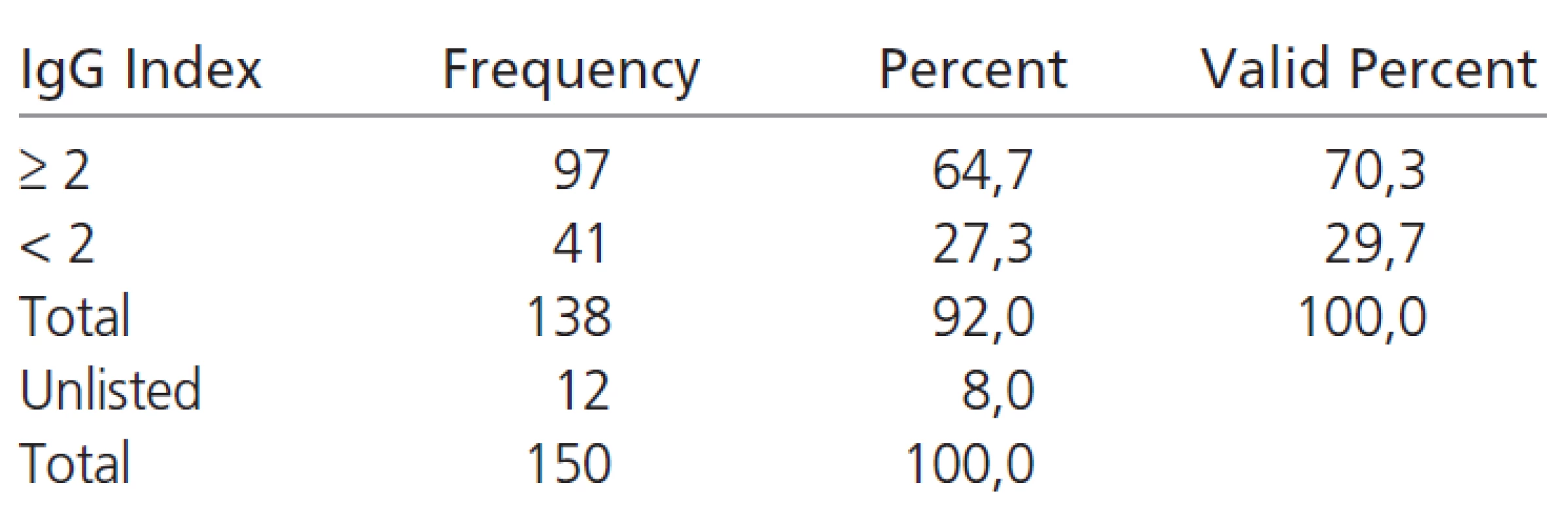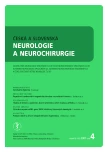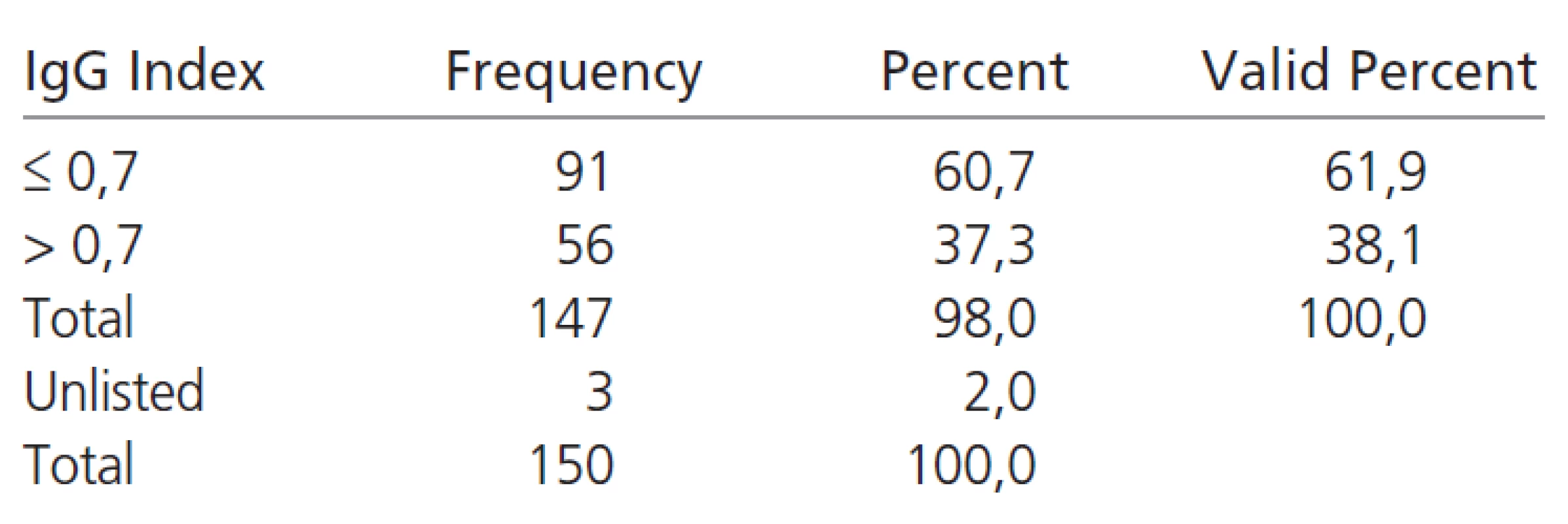-
Medical journals
- Career
Correlation of the IgG index and oligoclonal bands in the CSF of patients with multiple sclerosis
Authors: J. Mareš 1; R. Herzig 1; K. Urbánek 1; V. Sládková 1; R. Opavský 1; P. Hluštík 1; K. Kollárová 1; J. Podivínský 2; J. Sklenářová 3; V. Bekárek 3; P. Schneiderka 3; J. Zapletalová 4; P. Kaňovský 1
Authors‘ workplace: Department of Neurology, Palacký University Medical School and University Hospital, Olomouc, Czech Republic 1; Neurology Geriatric Medical Institution, Moravský Beroun 2; Department of Clinical Biochemistry, University Hospital, Olomouc, Czech Republic 3; Institute of Biophysics, Palacký University Medical School, Olomouc, Czech Republic 4
Published in: Cesk Slov Neurol N 2007; 70/103(4): 392-394
Category: Original Paper
Overview
Objective:
The aim of this study was to assess the correlation between IgG index values and the number of the oligoclonal IgG bands (OCB) in the cerebrospinal fluid (CSF) of patients with multiple sclerosis (MS).Material and Methods:
The set of 150 patients consisted of 41 males and 109 females (aged 18–68, mean 36.6 ± 10.1 years). The CSF collected by a lumbar puncture was examined evaluating intrathecal synthesis using the IgG index and determining OCB. The number of alkaline OCB in the CSF was assessed using the method of isoelectric focusation. Pearson's correlation analysis, and homogeneity χ2 test , Mann-Whitney test, paired-sample t-test (parametric) and Wilcoxon signed-ranks test (nonparametric) were used to evaluate the statistical significance of the results.Results:
No positive correlation between the IgG index and the number of OCB was found. Mann-Whitney test also did not demonstrate any significant difference of the IgG index values in patients both with the OCB number ≥ 2 and < 2.Conclusion:
This study did not confirm the correlation between the IgG index values and the OCB number in the CSF of MS patients.Key words:
oligoclonal bands – cerebrospinal fluid – IgG index – multiple sclerosisIntroduction
Immunoglobulins are glycoproteins produced by plasmocytes. In contrast to the known and characteristic reaction in the serum, where antibody production switches from the IgM to IgG class in the subacute and chronic phase of the disease, such a transition is not present in the intrathecal synthesis. The characteristic immunoglobulin pattern in classes IgG, IgM and IgA existing in the central nervous system (CNS) remains relatively constant already at the disease onset. Intrathecal IgG synthesis represents local IgG production within the CNS compartment, originates from perivascular infiltrates of B lymphocytes. Quantitative assessment of the intrathecal IgG synthesis is based on the relationship between IgG and albumin concentrations in the CSF and serum. Oligoclonal IgG immunoglobulins represent a primarily polyspecific and only subsequently an oligoclonal type of immune response. This produces an extensive spectrum of non-specific antibodies of „nonsense“ nature.
Information obtained by a detailed assessment of the CSF is currently unreplaceable for the diagnostics and monitoring of MS development. In all MS stages, increased IgG levels, which after correction for the function of the blood-brain barrier show their intrathecal synthesis, can be found. It is possible to demonstrate it as OCB by which the immunoglobulins participating in a destruction of the myelin covering of axons are lining up to special patterns. OCB assessment is the most specific CSF test for MS diagnosis [1] – their presence provides a significant support for this diagnosis, because they are not found in the serum of these patients and are therefore a proof of antibody production directly in the CNS. OCB are present (in the number of 2 or more) in the CSF of 95 - 100% of MS patients [2,3]. OCB can be present even in the case, when the CSF IgG level is normal. Finally, OCB are not specific only for MS - they are also found in various inflammatory disorders as well as in the chronic CNS infections. On the other hand, they are usually not present in neurodegenerative diseases, acute disseminated encephalomyelitis, Guillain-Barré syndrome, vascular, toxic, metabolic, traumatic or psychiatric disorders, radicular syndromes or in the majority of peripheral neuropathies [4]. OCB have a predictive value in the case of a negative magnetic resononace imaging finding (MRI), but there is no direct correlation between the OCB in the CSF and the demyelinating process as assessed by the MRI.
Determination of IgG index represents a quantitative detection of intrathecal synthesis. In the case of higher concentration of CSF IgG with normal levels of IgG in serum is the IgG index value elevated, regarding to the blood-brain barrier function. The limit for intrathecal synthesis detection is rated for 0,7. OCB represent a qualitative detection of intrathecal synthesis - OBC are detected by IEF usually in alkaline spectrum (event. neutral or paraneutral section) and are characterized by polyspecifity and oligoclonality.
The aim of this study was to assess the correlation between IgG index values and the OCB number in the CSF of patients with MS.
Material and Methods
The set of 150 MS patients (aged 18 - 68, mean 36.6 ± 10.1 years) consisted of 41 males and 109 females. The diagnosis of RRMS was established based on the McDonald’s criteria. All patients were treated at the Department of Neurology, University Hospital, Olomouc, Czech Republic, between 2001 and 2005.
In all patients, the CSF was collected by a routine lumbar puncture as part of the standard diagnostic process. The assessment of the IgG index and of the OCB was used for the evaluation of the intrathecal synthesis. IgG method of Pharmacia Biotech (Uppsala, Sweden) modified for using of acrylamid gel PhastGel ICF 3-9 and by isoelectric focusing (IEF) [5] with successive affinity immunoblot was used. The number of OCB in the CSF was assessed by the method of isoelectric focusation (IEF). The samples were examined in a laboratory with the international certificate for the IEF method (KB/0079). The IgG index was calculated from IgG and albumin measurements performed in CSF and serum. The calculation takes the following form: Index IgG = (IgGCSF/IgGSerum)/(AlbCSF/AlbSerum) = QIgG/QAlb.
Pearson’s correlation analysis, and homogeneity χ2 test, Mann-Whitney test, paired-sample t-test (parametric) and Wilcoxon signed-ranks test (nonparametric) were used to evaluate the statistical significance of the results, using SPSS-10 software package (SPSS, Chicago, USA). Sensitivity and specificity of the IgG index and the OCB number for the prediction of MS diagnosis were also assessed.
The whole study was conducted in accordance with the Helsinki Declaration of 1975 (as revised in 1983) and it was approved by local ethics committee of University Hospital in Olomouc, Czech Republic.
Results
Only OCB present in the CSF and absent from serum were considered. IgG index and the OCB number are summarized in the Tables 1 and 2.
2. Number of oligoclonal IgG bands. 
No positive correlation between the IgG index and the number of OCB was found by the Pearson´s correlation and nonparametric Spearman correlation. Using the Mann-Whitney also test did not demonstrate any significant difference of the IgG index values in patients both with the OCB number ≥ 2 and < 2.
We also have determined the sensitivity and the specificity of the technique used in our laboratory: characteristics of diagnostic test of IgG index >0,7 for prediction of MS diagnosis: sensitivity - 38,1%, specificity - 91,7 %, accuracy - 77, 6 %, positive predictive value - 62,2 %, negative predictive value - 80,5 %. Characteristics of diagnostic test of OCB number >=2 for prediction of MS diagnosis: sensitivity - 70,3 %, specificity - 76,1 %, accuracy - 74,4 %, positive predictive value - 53,3 %, negative predictive value - 86,8 %. Characteristics of diagnostic test both of of IgG index >0,7 and oligoclonal IgG bands number >=2 for prediction of MS diagnosis: sensitivity - 77,0 %, specificity - 73,7 %, accuracy - 74,6 %, positive predictive value - 51,1 %, negative predictive value - 90,0 %.
Figure 1. Correlation of the IgG index a OCB number. 
Discussion
The dynamics of the appearance and the development of OCB during the course of MS are not yet generally known [6]. In the study performed by Kaiser et al [7], only two cases (1%) out of the 185 CSF samples obtained from MS patients demonstrated the specificity of OCB antibodies against known CNS antigens. Livrea et al [8] did not find any correlation was found between the OCB pattern or amounts and age, duration, clinical course or therapy of the disease.
Concerning to correlation between the IgG index and OCB there is a lack of data in current literature - in study of Kaiser et al [9] were used two quantitative methods of determining the intrathecal synthesis of IgG for their usefulness in deciding about the necessity of further investigations of OCB in the CSF. While OCB could be detected in no patient with an IgG index < 0.45, OCB were always demonstrated in patients with an index > 0.80. Even though arrange of IgG index 0.45-0.8 values OCB was only detected in 268 out of 1316 patients (20.4%), in 190 out of 268 samples (70.8%)
Mayringer et al [10] found a positive correlation between the IgG index and the frequency of OCB as well as the probability of demyelinating CNS disease in patients with demyelinating CNS disease.
On the contrary we did not find any positive correlation between both parameters of intrathecal synthesis which is in accordance with study of Rochelli et al [11] - 63 out of 70 patients with definite MS and 24 out of 35 with probable MS had oligoclonal bands in the CSF and in the 18 patients with normal OCB pattern did not show any statistically significant difference as concerns the quantitative CSF parameters (IgG index, IgG synthesis and serum/CSF albumin quotient) compared to the patients with the OCB in CSF. Also in study of Poloni [12], in a group of 120 MS patients the group of 20 patients with normal IgG profile has been compared with a group of 22 patients selected by random out of the 100 with IgG oligoclonal bands and no statistically significant difference was discovered between these groups.
On the basis of our findings we can support the opinion about unsubsitutability of quantitative and qualitative methods in CSF assessment for use in differential diagnostics of MS. Because of lower diagnostic sensitivity, IgG index assessment cannot be recommended as replacement of IEF. Quantitative assessment of IgG in CSF is easier and quicker but qualitative method by IEF is the most sensitive method for detecting of abnormal intrathecal synthesis.
Conclusion
This study did not confirm the correlation between the IgG index values and the OCB number in the CSF of MS patients and support the opinion about unsubsitutability both of methods in MS diagnostics. Further studies are needed to assess this topic.
Přijato k recenzi: 19. 12. 2006
Přijato do tisku: 27. 2. 2007
Korespondence:
MUDr. Jan Mareš
Centrum pro diagnostiku a léčbu demyelinizačních onemocnění
Neurologická klinika
Fakultní nemocnice
I. P. Pavlova 6
775 20 Olomouc
e-mail: maresja@seznam.cz
Sources
1. Andersson M, Alvarez-Carmeno J, Bernardi G, Cogato I, Fredman P, Frederiksen J et al. Cerebrospinal fluid in the diagnosis of multiple sclerosis: A consensus report. J Neurol Neurosurg Psychiatry 1994; 57 : 897-902.
2. Caudie C, Allauzen O, Bancel J, Later R. Diagnostic usefullness of oligoclonal immunoglobulin G bands in cerebro-spinal fluid using isoelectric focusing in early diagnosis of multiple sclerosis. Ann Biol Clin (Paris) 20002; 58 : 187-193.
3. Miller JR, Burke AM, Bever CT. Occurence of oligoclonal bands in multiple sclerosis and other CNS diseases. Ann Neurol Jan 1983; 13(1): 53-58.
4. Sindic CHJM, Van Antwerpen MP, Goffette S. The Intrathecal Humoral Immune Response: Laboratory Analysis and Clinical Relevance. Clin Chem Lab Med 2001; 39(4): 333–340.
5. Correale J, de los Milagros Bassani Molinas M. Oligoclonal bands and antibody responses in multiple sclerosis. J Neurol 2002; 249 : 375-389.
6. Antel JP, Birnbaum G, Hartung HP. Clinical neuroimunology. London: Blackwell Science 1998 : 423.
7. Kaiser R, Obert M, Kaufmann R, Czygan M. IgG-antibodies to CNS proteins in patients with multiple sclerosis. Eur J Med Res 1997; 2(4): 169-172.
8. Livrea P, Trojano M, Simone IL, Zimatore GB, Lamontanara G, Leante R. Intrathecal IgG synthesis in multiple sclerosis: comparison between isoelectric focusing and quantitative estimation of cerebrospinal fluid IgG. J Neurol 1981; 224(3): 159-169.
9. Kaiser R, Czygan M, Kaufmann R, Lucking CH. Intrathecal IgG synthesis: when is determination of oligoclonal bands necessary? Nervenarzt 1995; 66(8): 618-23.
10. Mayringer I, Timeltaler B, Deisenhammer F. Correlation between the IgG index, oligoclonal bands in CSF, and the diagnosis of demyelinating diseases. Eur J Neurol 2005; 12(7): 527-530.
11. Rocchelli B, Poloni M, Mazzarello P, Delodovici M. Clinical and CSF findings in multiple sclerosis patients with or without IgG oligoclonal bands at isoelectric focusing examination of CSF and serum proteins. Eur Neurol 1983; 22(1): 35-42.
12. Poloni M, Rocchelli B, Mazzarello P, Delodovici M. Relation between the clinical and cerebrospinal fluid parameters in multiple sclerosis, with special reference to subjects without oligoclonal IgG in the cerebrospinal fluid. Riv Neurol 1981; 51(2): 69-80.
Labels
Paediatric neurology Neurosurgery Neurology
Article was published inCzech and Slovak Neurology and Neurosurgery

2007 Issue 4-
All articles in this issue
- Muscular biopsy in myotonic dystrophy in the era of molecular genetics
- Surgical treatment of hormonally active hypophysial adenomas
- Regulation of mRNA expression of the SMN2 gene by histone deacetylase inhibitors and their influence on the phenotype of type I and II spinal muscular atrophy
- Poliomyelitis-like syndrome caused by tick-meningoencephalitis
- Thrombosis of the sigmoid sinus – current views on diagnosing and treatment
- The treatment of sleep apnea in young children using bilevel positive airway pressure
- Swallowing difficulties in diffuse idiopathic skeletal hyperostosis
- Cervical dystonia
- Repetitive transcranial magnetic stimulation and chronic subjective tinnitus
- Levels of D-dimers in patients with acute ischaemic stroke
- Changes in congintive functions in patients with acute cerebrovascular event who tested by Mini-Mental State Examination and the Clock Drawing Test
- Decompressive craniectomy as treatment for a rat model of „malignant“ middle cerebral artery infarction
- Correlation of the IgG index and oligoclonal bands in the CSF of patients with multiple sclerosis
- Analysis of 1775 Patients Treated by Percutaneous Radiofrequency Rhizotomy for Trigeminal Neuralgia
- Czech and Slovak Neurology and Neurosurgery
- Journal archive
- Current issue
- Online only
- About the journal
Most read in this issue- Cervical dystonia
- Levels of D-dimers in patients with acute ischaemic stroke
- Thrombosis of the sigmoid sinus – current views on diagnosing and treatment
- Repetitive transcranial magnetic stimulation and chronic subjective tinnitus
Login#ADS_BOTTOM_SCRIPTS#Forgotten passwordEnter the email address that you registered with. We will send you instructions on how to set a new password.
- Career


